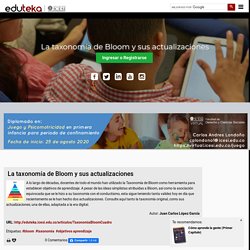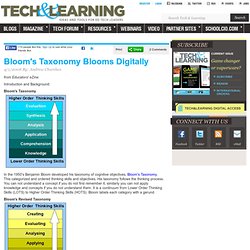

Two Examples of Taxonomies of Educational Outcomes. Instructional Goals and Objectives. La taxonomía de Bloom y sus actualizaciones. Recomendamos consultar el siguiente artículo:TAXONOMÍA DE BLOOM PARA LA ERA DIGITAL Han pasado más de cincuenta años y la Taxonomía de Bloom continúa siendo herramienta fundamental para establecer objetivos de aprendizaje.

En el 2000 fue revisada por uno de sus discípulos quien, para cada categoría, cambió tanto el uso de sustantivos por verbos, como su secuencia. Recientemente, el doctor Andrew Churches actualizó dicha revisión para ponerla a tono con las nuevas realidades de la era digital. En ella, complementó cada categoría con verbos y herramientas del mundo digital que posibilitan el desarrollo de habilidades para Recordar, Comprender, Aplicar, Analizar, Evaluar y Crear. La idea de establecer un sistema de clasificación de habilidades, comprendido dentro de un marco teórico, surgió en una reunión informal al finalizar la Convención de la Asociación Norteamericana de Psicología, reunida en Boston (USA) en 1948.
Bloom's Taxonomy Blooms Digitally. 4/1/2008 By: Andrew Churches from Educators' eZine Introduction and Background: Bloom's Taxonomy In the 1950's Benjamin Bloom developed his taxonomy of cognitive objectives, Bloom's Taxonomy.

This categorized and ordered thinking skills and objectives. Bloom's Revised Taxonomy In the 1990's, a former student of Bloom, Lorin Anderson, revised Bloom's Taxonomy and published this- Bloom's Revised Taxonomy in 2001.Key to this is the use of verbs rather than nouns for each of the categories and a rearrangement of the sequence within the taxonomy. Bloom's Revised Taxonomy Sub Categories Each of the categories or taxonomic elements has a number of key verbs associated with it Lower Order Thinking Skills (LOTS) Higher Order Thinking Skills (HOTS) The elements cover many of the activities and objectives but they do not address the new objectives presented by the emergence and integration of Information and Communication Technologies into the classroom and the lives of our students.
Blooms-activity-analysis.pdf (application/pdf Object) Blooming Orange: Bloom's Taxonomy Helpful Verbs Poster. Here’s another poster to help get you thinking about how you can apply Bloom’s higher-order thinking skills with your children.

This poster shows the segments of an orange with each segment relating to a thinking skill and some helpful verbs to serve as prompts. While there are many more verbs that we could have added, we felt that including just seven in each segment would make them easier to remember (For more information, see Miller’s paper “The Magical Number Seven, Plus or Minus Two: Some Limits on Our Capacity for Processing Information.” We thought it would be interesting to depict the verbs in a circular form as opposed to a hierarchical list, given that these skills don’t often occur in isolation and are interconnected.
We went through several concepts including a wheel, a pie, and an apple, but somehow the orange seemed to work best when we put everything together. For those of you who prefer it, we’ve also created a grayscale version of the poster. Inverting Bloom's Taxonomy. Bloom’s Taxonomy « Digital Tools. There are some excellent resources available on the web on Bloom’s Digital taxonomy.

This digital version of the taxonomy accounts for the new technologies and the processes and actions associated with them. This Diigo list has many references, In particular see Andrew Churches’ Wiki which contains extensive resources. His Quick Sheets provide a quick reference and relate Digital Taxonomy Verbs and possible activities to the different taxonomic levels.LiveBinders version of these resources. This Prezi shows suggestions for Web 2.0 tools relating to Bloom’s Digital Taxonomy. (See the Presentations page for further information on Prezi). Kathy Schrock has created ‘Bloomin’ Google‘ where she has categorised Google tools according to Bloom’s revised taxonomy. Her blog post explains its origins.
Irena Kay’s ‘Bloom’s Taxonomy – Revised’ Like this: Recommended Link from Russel Tarr at www.activehistory.co.uk.